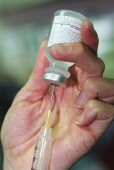
WEDNESDAY, Dec. 9 (HealthDay News) — Although the H1N1 pandemic flu has raised public awareness of the flu in general, there has been only a slight increase in the number of people choosing to get a seasonal flu shot, a new report shows.
By the middle of November, only about 32 percent of adults for whom the vaccine is recommended had gotten a shot, according to the survey. Seasonal flu vaccine is recommended for all adults aged 50 and over, people with chronic conditions such as asthma, diabetes, heart disease, chronic lung disease, as well as health-care workers and people who come into contact with those at risk for flu.
“Health-care professionals and the public really took to heart the advice to both give and get seasonal vaccine early this year,” report author Katherine Harris, an economist at RAND Corp., said during a teleconference Wednesday.
“By early September, about three times as many adults had received seasonal influenza vaccine compared to the same time last year,” she said. “The early lead had pretty much diminished by mid-November.”
The findings are based on a national survey of more than 5,000 adults conducted online between Nov. 4 and Nov. 16 about their vaccination status and related issues.
Among adults not vaccinated at the time of the survey, 17 percent said they planned to get a flu shot, as did 19 percent of those at risk for flu complications.
While the total number of adults getting their seasonal flu shot has remained about the same, adults started getting their shot earlier this year than in the past.
In addition, about 50 percent of health-care workers had gotten a flu shot by the middle of November, which is about the same number of health-care workers who were vaccinated in all of last year’s flu season. Still, 39 percent of health-care workers said they did not intend to get vaccinated, according to the report.
Shortages of seasonal flu vaccine appear to account for the slowdown in vaccinations. In fact, 38 percent of adults looking to get vaccinated could not find any.
The importance of getting vaccinated cannot be overstated, Dr. William Schaffner, president-elect of the National Foundation for Infectious Diseases, said during the teleconference.
“This is a disease that causes 200,000 hospitalizations each year and 36,000 deaths,” he said. “Anything we can do to provide protection against those complications is important.”
The main reason that so many adults say they will not get vaccinated are misconceptions about the vaccine, Harris said.
“Overall, 60 percent of those who don’t intend to be vaccinated this year pointed toward the possibility of becoming sick, experiencing side effects, not believing in vaccine or not needing vaccine,” she said.
You can’t get flu from the flu vaccine, Schaffner said. “That is categorically incorrect. It is an urban and rural myth that keeps circulating.”
Schaffner urged adults to get vaccinated, noting that the seasonal flu usually peaks in February. So there is plenty of time to protect yourself from possible infection, he said.
Other findings in the report include:
- People did not appear to be forgoing seasonal influenza vaccine because they were getting H1N1 flu vaccine.
- Health-care providers were the best source of information about flu shots, according to 44 percent of vaccinated adults.
- Unvaccinated adults relied on news reports rather than health-care providers for information about influenza vaccine.
- Some 44 percent of adults with chronic diseases have been vaccinated.
- Whites were more likely to be vaccinated, while Hispanics were the least likely to have been vaccinated.
In addition to adults, the U.S. Centers for Disease Control and Prevention recommends that children and adolescents aged 6 months to 18 years get the seasonal vaccine.
According to the CDC, with the spread of the H1N1 swine flu, many people will need both the seasonal flu and the swine flu vaccine. Those who should get the H1N1 vaccine include health-care workers, children and young adults, people with underlying chronic conditions and people who care for infants.
The report released Wednesday was paid for by the pharmaceutical giant GlaxoSmithKline, a major manufacturer of influenza vaccine.
More information
For more information on flu, visit the U.S. Centers for Disease Control and Prevention.

